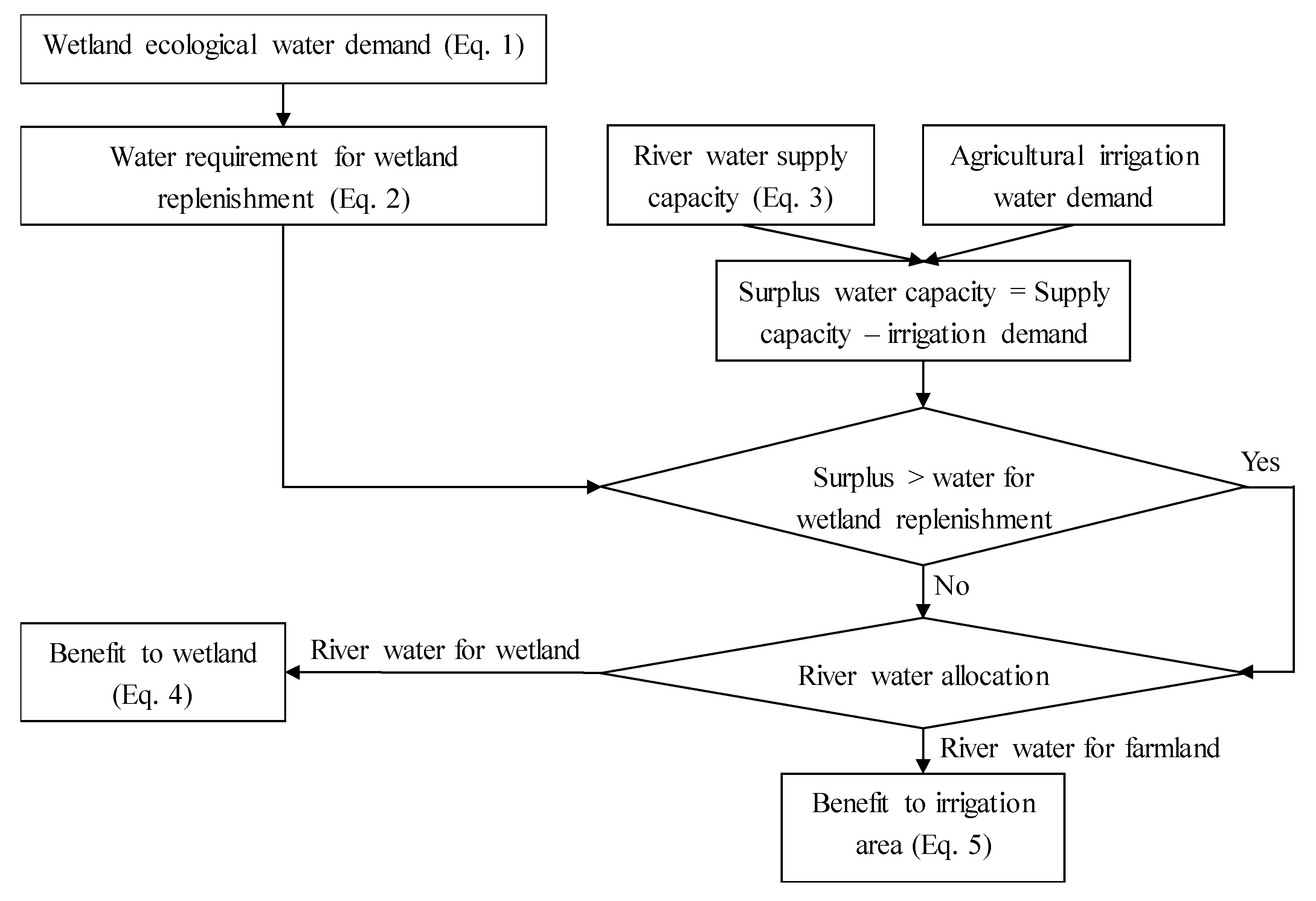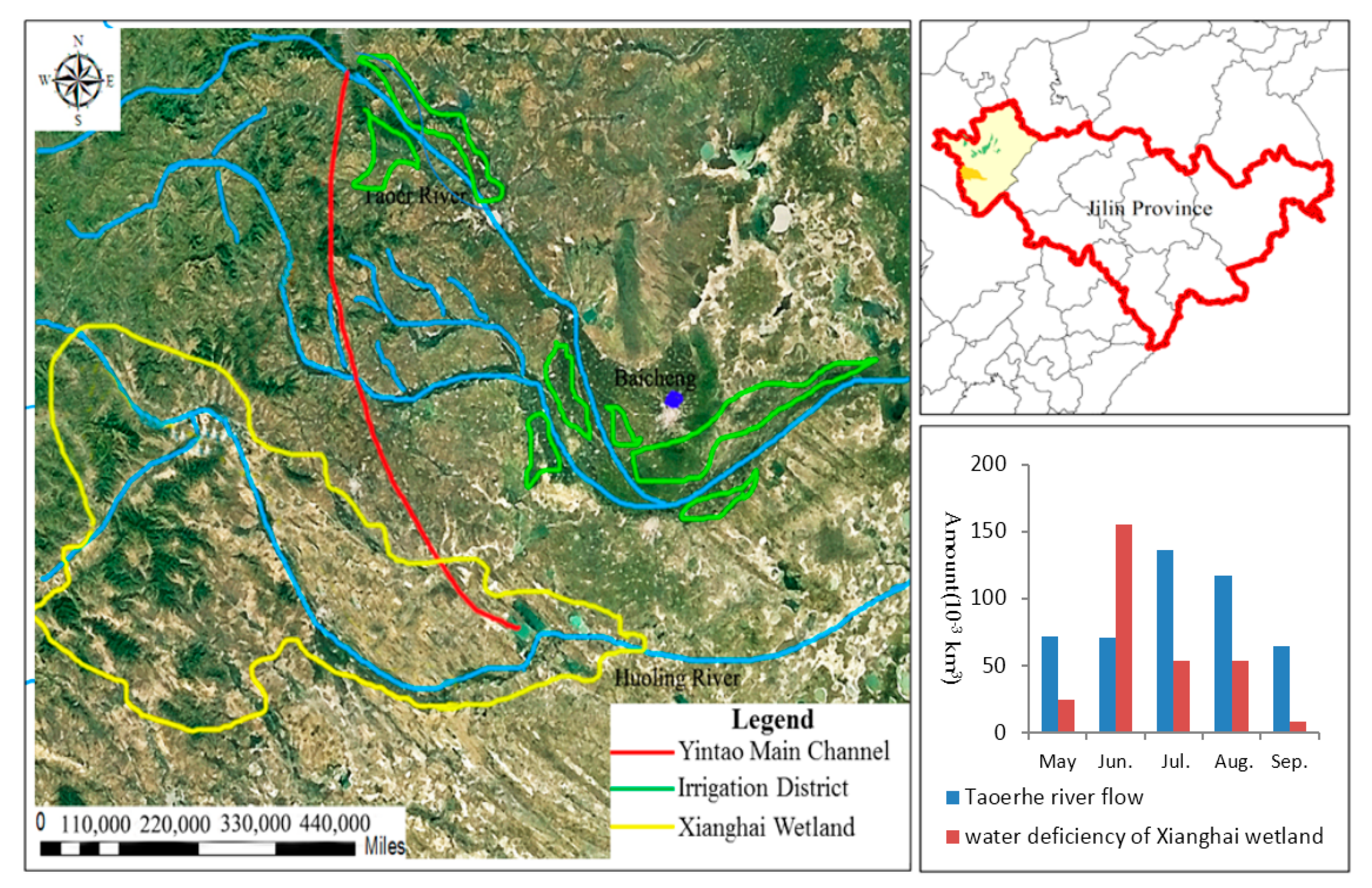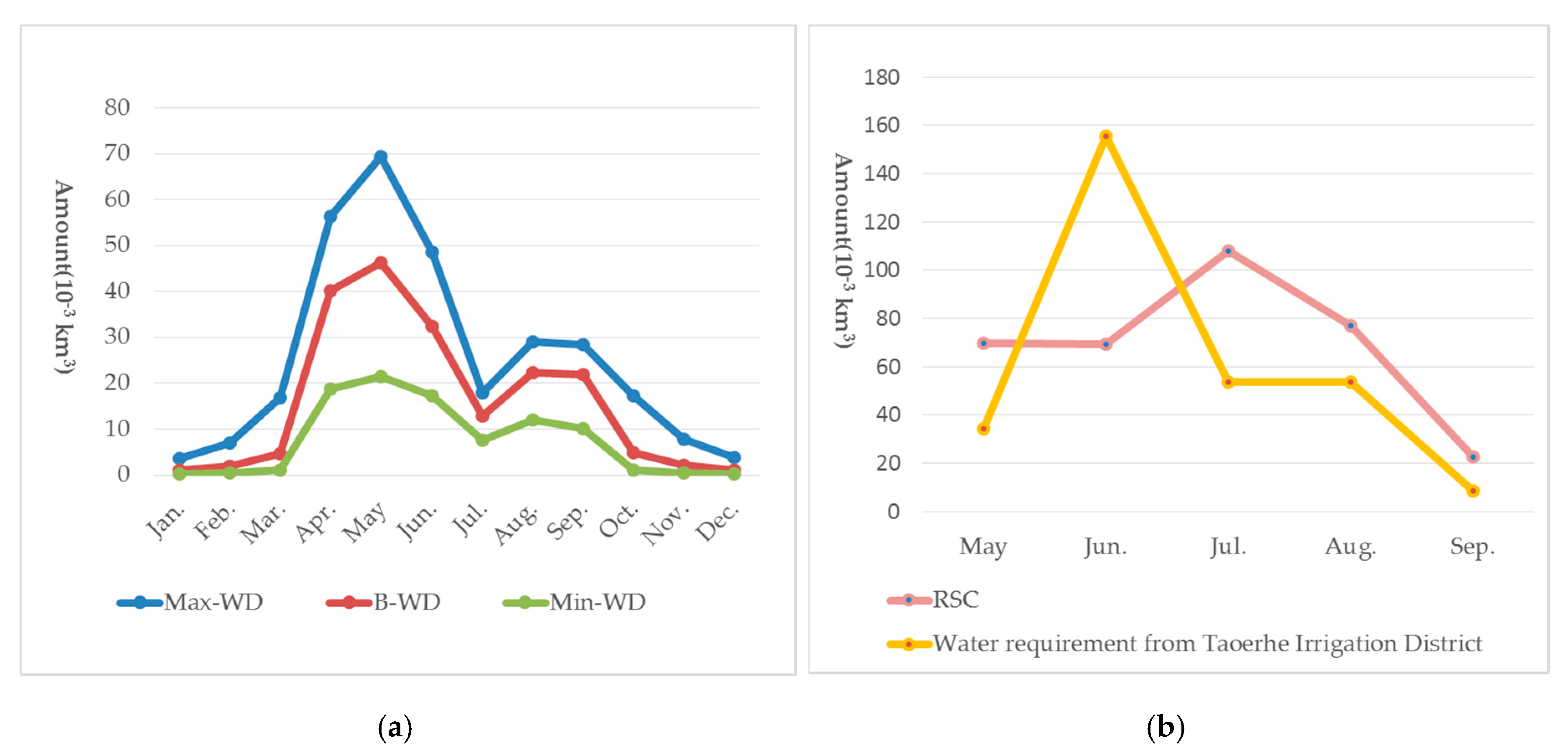A Holistic Wetland Ecological Water Replenishment Scheme with Consideration of Seasonal Effect
Abstract
1. Introduction
2. Methodology
2.1. The WD and Water Replenishment
2.2. The RSC in Different Seasons
2.3. The Benefit of River Water Diversion
2.3.1. The Benefit to Wetland
2.3.2. The Benefit to Irrigation Area
2.4. Scenario Description
3. Study Area
3.1. Xianghai Wetland
3.2. River Water Supply of the Xianghai Wetland
3.3. Taoerhe Irrigation District (TID)
3.4. Data Sources
4. Result and Discussion
4.1. Xianghai Wetland Water Demand and the Taoerhe River Water Supply Capacity
4.2. Wetland Ecological WRS
4.3. Seasonal Effect on the Wetland Ecological Water Replenishment Scheme
5. Conclusions
Author Contributions
Acknowledgments
Conflicts of Interest
References
- Engelhardt, K.A.M.; Ritchie, M.E. Effects of macrophyte species richness on wetland ecosystem functioning and services. Nature 2001, 7, 687–689. [Google Scholar] [CrossRef]
- Woodward, R.T.; Wui, Y.S. The economic value of wetland services: A meta-analysis. Ecol. Econ. 2001, 37, 257–270. [Google Scholar] [CrossRef]
- Thorslund, J.; Jarsjo, J.; Jaramillo, F.; Jawitz, J.W.; Manzoni, S. Wetlands as large-scale nature-based solutions: Status and challenges for research, engineering and management. Ecol. Eng. 2017, 108, 489–497. [Google Scholar] [CrossRef]
- Jaramillo, F.; Licero, L.; Ahlen, I.; Manzoni, S.; Rodríguez-Rodríguez, J.A.; Guittard, A.; Hylin, A.; Bolanos, J.; Jawitz, J.; Wdowinski, S.; et al. Effects of Hydroclimatic Change and Rehabilitation Activities on Salinity and Mangroves in the Ciénaga Grande de Santa Marta, Colombia. Wetlands 2018, 38, 755–767. [Google Scholar] [CrossRef]
- Niu, Z.; Zhang, H.; Wang, X.; Yao, W.; Zhou, D.; Zhao, K.; Zhao, H.; Li, N.; Huang, H.; Li, C.; et al. Mapping wetland changes in China between 1978 and 2008. Chinese Science Bulletin 2012, 57, 2813–2823. [Google Scholar] [CrossRef]
- Jia, H.; Ma, H.; Wei, M. Calculation of the minimum ecological water requirement of an urban river system and its deployment: A case study in Beijing central region. Ecol. Model. 2011, 222, 3271–3276. [Google Scholar] [CrossRef]
- Wang, Y.L. Study on Ecological Compensation Mechanism of Water Replenishment to Xianghai Wetland; Jilin University: Changchun, China, 2012. (In Chinese) [Google Scholar]
- Tan, Y.Y.; Wang, X.; Li, C.H.; Cai, Y.P.; Yang, Z.F.; Wang, Y.L. Estimation of ecological flow requirement in Zoige Alpine Wetland of southwest China. Environ. Earth Sci. 2012, 66, 1525–1533. [Google Scholar] [CrossRef]
- Mawhinney, W.A. Restoring biodiversity in the Gwydir wetlands through environmental flows. Water Sci. Technol. 2003, 48, 73–81. [Google Scholar] [CrossRef] [PubMed]
- Kingsford, R.D.; Auld, K.M. Waterbird breeding and environmental flow management in the Macquarie marshes, arid Australia. River Res. Appl. 2005, 21, 187–200. [Google Scholar] [CrossRef]
- Richardson, C.J.; Reiss, P.; Hussain, N.A.; Alwash, A.J.; Pool, D.J. The restoration potential of the Mesopotamian marshes of Iraq. Science 2005, 307, 1307–1311. [Google Scholar] [CrossRef] [PubMed]
- Powell, S.J.; Letcher, R.A.; Croke, B.F.W. Modeling floodplain inundation for environmental flows: Gwydir wetlands, Australia. Ecol. Model. 2008, 211, 350–362. [Google Scholar] [CrossRef]
- Yang, Z.F.; Sun, T.; Cui, B.S.; Chen, B.; Chen, G.Q. Environmental flow requirements for integrated water resources allocation in the Yellow River Basin, China. Commun. Nonlinear Sci. Numer. Simul. 2009, 14, 2469–2481. [Google Scholar] [CrossRef]
- Chen, H.; Zhao, Y.W. Evaluating the environmental flows of China’s Wolonghu wetland and land use changes using a hydrological model, a water balance model, and remote sensing. Ecol. Model. 2011, 222, 253–260. [Google Scholar] [CrossRef]
- Gippel, G.J.; Stewardson, M.J. Use of wetted perimeter in defining minimum environmental flows. Rivers Res. Manag. 1998, 14, 53–67. [Google Scholar] [CrossRef]
- Yang, Z.F.; Cui, B.S.; Liu, J.L. Estimation methods of eco-environmental water requirements: Case study. Sci. China Ser. D Earth Sci. 2005, 48, 1280–1292. [Google Scholar] [CrossRef]
- Zang, Z.; Zheng, D.F.; Sun, C.Z. Evaluation of wetland ecological benefit and restoration in the natural reserves of western Jilin Province, China. J. Appl. Ecol. 2014, 25, 1447–1454. [Google Scholar]
- Luo, Z.L.; Zuo, Q.T.; Shao, Q.X. A new framework for assessing river ecosystem health with consideration of human service demand. Sci. Total Environ. 2018, 640, 442–453. [Google Scholar] [CrossRef]
- Cui, B.S.; Tang, N.; Zhao, X.S. A management-oriented valuation method to determine ecological water requirement for wetlands in the Yellow River Delta of China. J. Nat. Conserv. 2009, 17, 129–141. [Google Scholar] [CrossRef]
- Ma, C.; Zhang, G.Y.; Zhang, X.C. Water Resource Management for Wetland Restoration Engineering in Tianjin Coastal Area in China. In Proceedings of the 1st International Conference on Energy and Environmental Protection, Hohhot, China, 23 June 2012; pp. 4333–4336. [Google Scholar]
- Filiz, D.C. Impact of Large-Scale Irrigation on a Closed Basin Wetland: Water Flow Alterations and Participatory Irrigation Management Effects on the Sultan Marshes Ecosystem in Turkey; University of Minnesota: Minneapolis, MN, USA, 2008; pp. 131–153. [Google Scholar]
- Audrey, D.L.; Takashi, A. Recovering sustainable water from wastewater. Environ. Sci. Technol. 2004, 38, 201A–208A. [Google Scholar]
- Calzadilla, A.; Rehdanz, K.; Betts, R.; Falloon, P.; Wiltshire, A.; Tol, R.S.J. Climate change impacts on global agriculture. Clim. Chang. 2013, 120, 357–374. [Google Scholar] [CrossRef]
- Campbell, B.; Beare, D.; Bennett, E.; Hall-Spencer, J.; Ingram, J.S.I.; Jaramillo, F.; Ortiz, R.; Ramankutty, N.; Sayer, J.A.; Shindell, D. Agriculture production as a major driver of the Earth system exceeding planetary boundaries. Ecol. Soc. 2017, 22, 8. [Google Scholar] [CrossRef]
- Lafitte, H.R.; Courtois, B. Interpreting cultivation environment interactions for yield in upland rice: Assigning value to drought-adaptive traits. Crop Sci. 2002, 42, 1409–1420. [Google Scholar] [CrossRef]
- Alou, I.N.; Steyn, J.M.; Annandale, J.G. Growth, phenological, and yield response of upland rice (Oryza sativa L. cv. Nerica 4 (R)) to water stress during different growth stages. Agric. Water Manag. 2018, 198, 39–52. [Google Scholar] [CrossRef]
- Nepal, C.D.; Ratnajit, S.; Mahmood, P.; Sujit, K.B. Sustainability of groundwater use for irrigation of dry-season crops in northwest Bangladesh. Groundw. Sustain. Dev. 2017, 4, 66–77. [Google Scholar]
- De Rensis, F.; Lopez-Gatius, F.; García-Ispierto, I.; Morini, G.; Scaramuzzi, R.J. Causes of declining fertility in dairy cows during the warm season. Theriogenology 2017, 91, 145–153. [Google Scholar] [CrossRef] [PubMed]
- Cui, B.S.; Yang, Z.F. Eco-environmental water requirement for wetlands in Huang-Huai-Hai Area, China. Prog. Nat. Sci. 2002, 12, 841–848. [Google Scholar]
- Liu, X.H.; Lv, X.G.; Jiang, M.; Shang, L.N.; Wang, X.G. Research on the valuation of wetland ecosystem services. Acta Ecol. Sin. 2008, 28, 5625–5631, (In Chinese, with English abstract). [Google Scholar]
- Costanza, R.; Arfe, R.; Groot, R.; Farber, S.; Grasso, M.; Hannon, B.; Limburg, K.; Naeem, S.; O’neill, R.V.; Paruelo, J.; et al. The value of the world’s ecosystem services and natural capital. Nature 1997, 387, 253–260. [Google Scholar] [CrossRef]
- Hein, L.; Van Koppen, V.; de Groot, R.S.; van lerland, E.C. Spatial scales, stakeholders and the valuation of ecosystem services. Ecol. Econ. 2006, 57, 209–228. [Google Scholar] [CrossRef]
- Yu, J.H.; Ding, B.R. Study on the relationship between water consumption and yield of crop under insufficient irrigation. Water Sav. Irrig. (China) 2010, 7, 41–43. [Google Scholar]
- Masuya, Y.; Shimono, H. Mining a yield-trial database to identify high-yielding cultivars by simulation modeling: A case study for rice. J. Agric. Meteorol. 2017, 73, 51–58. [Google Scholar] [CrossRef]
- An, N.; Wei, W.L.; Qiao, L. Agronomic and environmental causes of yield and nitrogen use efficiency gaps in Chinese rice farming systems. Eur. J. Agron. 2018, 93, 40–49. [Google Scholar] [CrossRef]
- Wang, D.L.; Lin, Z.F.; Wang, T. An analogous woodbarrel theory to explain the occurrence of hormesis: A case study of sulfonamides and erythromycin on Escherichia coli growth. PLoS One 2017, 12, e0181321. [Google Scholar]
- Sheng, J.; Shen, S.H.; Gu, Z. Conversion coefficient of water surface evaporation of small evaporator. J. Nanjing Meteorol. Univ. 2007, 4, 562–563. (In Chinese) [Google Scholar]
- Tang, Y.; Wang, H.; Yan, D.H. Study on ecological water demand of wetland in xianghai nature reserve. J. Resour. Sci. 2005, 5, 101–106. [Google Scholar]
- Li, F.; Zhang, S.W.; Yang, J.C. The effects of population density changes on ecosystem services value: A case study in Western Jilin, China. Ecol. Indic. 2016, 61, 328–337. [Google Scholar]
- Xiao, Y.; Xie, G.D.; An, K. Economic value of ecosystem services in Mangcuo Lake drainage basin. Chin. J. Appl. Ecol. 2003, 14, 676–680. [Google Scholar]
- Yu, M.; Wang, C.R.; Liu, Y.; Gustaf, O.; Wang, C.Y. Sustainability of mega water diversion projects: Experience and lessons from China. Sci. Total Environ. 2018, 619–620, 721–731. [Google Scholar] [CrossRef] [PubMed]
- Zhao, Z.Y.; Zuo, J.; Zillante, G. Transformation of water resource management: A case study of the South-to-North Water Diversion project. J. Clean. Prod. 2017, 163, 136–145. [Google Scholar] [CrossRef]
- Yang, Z.F.; Mao, X.F. Wetland system network analysis for environmental flow allocations in the Baiyangdian Basin, China. Ecol. Model. 2011, 222, 3785–3794. [Google Scholar] [CrossRef]
- Null, S.E.; Prudencio, L. Climate change effects on water allocations with season dependent water rights. Sci. Total Environ. 2016, 571, 943–954. [Google Scholar] [CrossRef] [PubMed]



| Data or Parameters | Values | Units | References | |
|---|---|---|---|---|
| Acreage of the Xianghai wetland (Ak) | The report of “Remote Sensing Dynamic Analysis Report of Land Use in Songnen Plain Wetland Nature Reserve” which come from China Songliao River Basin Commission. | |||
| The largest area (k = 1) | Lakes acreage | 4.427 × 103 | km2 | |
| Reservoirs acreage | 2.376 × 104 | |||
| Plants acreage | 2.403 × 104 | |||
| Others | 5.325 × 104 | |||
| The average area (k = 2) | Lakes acreage | 1.218 × 103 | km2 | |
| Reservoirs acreage | 6.538 × 103 | |||
| Plants acreage | 2.403 × 104 | |||
| Others | 3.244 × 104 | |||
| The core area (k = 3) | Acreage of lakes and reservoirs | 1.517 × 103 | km2 | |
| Plants acreage | 1.084 × 104 | |||
| Others | 1.663 × 104 | |||
| Environmental flow (Qeco,i) | 2 × 10−3 | km3 | [7] | |
| Coefficient | Water evaporation (α) | 0.5–0.6 | dimensionless | [37] |
| Plant evapotranspiration (γ) | 1.1–2.5 | [38] | ||
| Natural water in the dry year () (guaranteed rates of 75%) | May | 0 | km3 | Monitoring and statistical data provided by Hydrology Bureau of Baicheng City |
| June | 0 | |||
| July | 2.3 × 10−2 | |||
| August | 3.8 × 10−2 | |||
| September | 4 × 10−2 | |||
| The benefit of using surface water in irrigation area | The theoretical rice output under the conditions of surface water irrigation (Ys) | 8000 | kg | Provided by Taoerhe Irrigation District Authority |
| The rice output difference between surface water irrigation and groundwater irrigation(Δ Ys-g) | 2.2 × 105 | kg/km2 | ||
| The c rice price under the conditions of surface water irrigation (Ps) | 0.55 | $/kg | ||
| The rice price difference between surface water irrigation and groundwater irrigation(Δ Ps-g) | 0.09 | $/kg | ||
| The cost difference between surface water irrigation and groundwater irrigation(Δ c) | 9.848 × 103 | $/km2 | ||
| Ecosystem service value coefficients (δg) | Climate regulation | 1.613 × 104 | Million $/km2 | [30,39,40] |
| Water storage | 9.046 × 104 | |||
| Soil formation and conservation | 5.033 × 103 | |||
| Biodiversity maintenance | 4.061 × 104 | |||
| Recreation and culture | 2.556 × 104 | |||
| The water sensitivity index of rice (θi) | Mid-tilling (MT) stage | 0.2826 | dimensionless | [33] |
| Elongation stage | 0.6284 | |||
| Efflorescence and filling stage | 0.4406 | |||
| Maturation stage | 0.1086 | |||
| May | June | July | Aug. | Sep. | Total | ||
|---|---|---|---|---|---|---|---|
| River water supply capacity of the Taoerhe River | 6.978 × 10−2 | 6.928 × 10−2 | 0.108 | 7.705 × 10−2 | 2.28 × 10−2 | 0.347 | |
| Water requirement from the Taoerhe irrigation district | 3.450 × 10−2 | 0.156 | 5.356 × 10−2 | 5.356 × 10−2 | 8.64 × 10−3 | 0.306 | |
| Xianghai wetland water requirement for the minimum wetland ecological water demand | 4.971 × 10−2 | 3.989 × 10−2 | 0 | 0 | 0 | − | |
| Scenario I | Taoerhe Irrigation District | 3.45 × 10−2 | 6.928 × 10−2 | 5.356 × 10−2 | 5.356 × 10−2 | 8.64 × 10−3 | 0.220 |
| Xianghai wetland | 3.528 × 10−2 | 0 | 5.429 × 10−2 | 2.349 × 10−2 | 1.416 × 10−2 | 0.127 | |
| Water deficiency ratio | 0.00% | 0.00% | 0.00% | 0.00% | 0.00% | ||
| Scenario II | Xianghai wetland | 6.978 × 10−2 | 6.928 × 10−2 | 0.108 | 7.705 × 10−2 | 2.28 × 10−2 | 0.347 |
| Taoerhe Irrigation District | 0 | 0 | 0 | 0 | 0 | 0 | |
| Water deficiency ratio | 100.00% | 44.55% | 100.00% | 100.00% | 100.00% | − | |
| Scenario III | Xianghai wetland | 4.476 × 10−2 | 4.476 × 10−2 | 4.476 × 10−2 | 4.476 × 10−2 | 2.28 × 10−2 | 0.202 |
| Taoerhe Irrigation District | 2.502 × 10−2 | 2.452 × 10−2 | 6.309 × 10−2 | 3.229 × 10−2 | 0 | 0.145 | |
| Water deficiency ratio | 27.49% | 28.78% | 0.00% | 39.72% | 100.00% | − | |
| Scenario IV | Xianghai wetland | 4.971 × 10−2 | 3.989 × 10−2 | 6.369 × 10−2 | 3.289 × 10−2 | 1.568 × 10−2 | 0.202 |
| Taoerhe Irrigation District | 2.007 × 10−2 | 2.939 × 10−2 | 4.416 × 10−2 | 4.416 × 10−2 | 7.12 × 10−3 | 0.145 | |
| Water deficiency ratio | 41.83% | 25.65% | 17.54% | 17.54% | 17.54% | − | |
| Wetland Benefit | Irrigation Area Benefit | Total Benefit | ||||
|---|---|---|---|---|---|---|
| Crop Output | Crop Quality | Water Cost | Benefit | |||
| Scenario I | 32.82 | 39.84 | 24.15 | 2.35 | 66.33 | 99.15 |
| Scenario II | 89.46 | 0 | 0 | 0 | 0 | 89.46 |
| Scenario III | 52.07 | 21.21 | 0.00 | 1.55 | 22.76 | 74.83 |
| Scenario IV | 52.07 | 36.35 | 14.05 | 1.55 | 51.95 | 104.02 |
© 2019 by the authors. Licensee MDPI, Basel, Switzerland. This article is an open access article distributed under the terms and conditions of the Creative Commons Attribution (CC BY) license (http://creativecommons.org/licenses/by/4.0/).
Share and Cite
Duan, H.; Xu, M.; Cai, Y.; Wang, X.; Zhou, J.; Zhang, Q. A Holistic Wetland Ecological Water Replenishment Scheme with Consideration of Seasonal Effect. Sustainability 2019, 11, 930. https://doi.org/10.3390/su11030930
Duan H, Xu M, Cai Y, Wang X, Zhou J, Zhang Q. A Holistic Wetland Ecological Water Replenishment Scheme with Consideration of Seasonal Effect. Sustainability. 2019; 11(3):930. https://doi.org/10.3390/su11030930
Chicago/Turabian StyleDuan, Haiyan, Menghong Xu, Yu Cai, Xianen Wang, Jialong Zhou, and Qiong Zhang. 2019. "A Holistic Wetland Ecological Water Replenishment Scheme with Consideration of Seasonal Effect" Sustainability 11, no. 3: 930. https://doi.org/10.3390/su11030930
APA StyleDuan, H., Xu, M., Cai, Y., Wang, X., Zhou, J., & Zhang, Q. (2019). A Holistic Wetland Ecological Water Replenishment Scheme with Consideration of Seasonal Effect. Sustainability, 11(3), 930. https://doi.org/10.3390/su11030930





